Kulich tsar
 4 hours (your 3 hours 10 min)
4 hours (your 3 hours 10 min)4 hours your 3 hours 10 min
Tsar's cake is a rich sdoba, and in the filling - sweet candied fruits and certainly almonds. You can forget about all kinds of diets on Easter and when preparing cakes, do not save on eggs, cream and oil.
Cream - 550 g, Live pressed yeast - 50 g, or dry yeast - 17 g, Wheat flour - 1.2 kg, Butter - 200g, Sugar - 200g, Cardamom - 10 grains, Yolks - 15 pcs., Nutmeg whole - 1 pc., or nutmeg ground - 1 tsp, Almonds - 50 g, Zucaty - 100 g, Raisins - 100 g, breadcrumbs for dusting - 2 tbsp.
 One puts thick steam on 400 g of wheat flour. It is advisable to take a large container for the dough in order to continue kneading the dough in it. The yeast mixture is stirred and placed in a warm place without drafts for 30-40 minutes. You can put the dough on the proofing in the oven, for this you need to heat it up to 35 degrees. You can also put a container with steam next to the stove, and put a pot of water on the stove, on a medium heat. If you have heat in your kitchen, it will be enough just to leave the steam on the table.
One puts thick steam on 400 g of wheat flour. It is advisable to take a large container for the dough in order to continue kneading the dough in it. The yeast mixture is stirred and placed in a warm place without drafts for 30-40 minutes. You can put the dough on the proofing in the oven, for this you need to heat it up to 35 degrees. You can also put a container with steam next to the stove, and put a pot of water on the stove, on a medium heat. If you have heat in your kitchen, it will be enough just to leave the steam on the table.  Yolks are separated from proteins. One way is to break the egg gently into a deep plate to avoid damaging the yolk, then remove the yolk with your fingers and place it in a separate bowl. Another way: break the egg into 2 parts without damaging the yolk, taking your time to shift the egg from one shell to another, until the protein flows into a bowl and the yolk remains in the shell.
Yolks are separated from proteins. One way is to break the egg gently into a deep plate to avoid damaging the yolk, then remove the yolk with your fingers and place it in a separate bowl. Another way: break the egg into 2 parts without damaging the yolk, taking your time to shift the egg from one shell to another, until the protein flows into a bowl and the yolk remains in the shell.  When the opara rises, egg yolks ground with butter and sugar sand (oils and sugars of 200 g, 15 yolks) are added to it, another 800 g of flour, two small cups of cream (300 g), crushed cardamom (10 grains), 1 crushed nutmeg, chopped almonds (50 g), 100 g of finely chopped candied fruits and prepared raisins.
When the opara rises, egg yolks ground with butter and sugar sand (oils and sugars of 200 g, 15 yolks) are added to it, another 800 g of flour, two small cups of cream (300 g), crushed cardamom (10 grains), 1 crushed nutmeg, chopped almonds (50 g), 100 g of finely chopped candied fruits and prepared raisins. 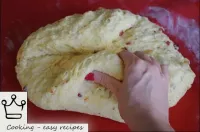 Dough is thoroughly and for a long time kneaded to give porosity and pomp to future cakes. At first, the kneading can be done with a spatula, as soon as all the flour is dispersed, you can switch to manual kneading of the dough. The table is sprinkled with flour and dough is laid out. They are kneaded for about 15-20 minutes with two hands, folding the edges of the dough to the middle and crumpling them with force. For the first few minutes, the dough will stick strongly to the hands, this can be avoided by lubricating the hands with vegetable oil. 1 tbsp. a spoonful of oil for the entire kneading process should be enough.
Dough is thoroughly and for a long time kneaded to give porosity and pomp to future cakes. At first, the kneading can be done with a spatula, as soon as all the flour is dispersed, you can switch to manual kneading of the dough. The table is sprinkled with flour and dough is laid out. They are kneaded for about 15-20 minutes with two hands, folding the edges of the dough to the middle and crumpling them with force. For the first few minutes, the dough will stick strongly to the hands, this can be avoided by lubricating the hands with vegetable oil. 1 tbsp. a spoonful of oil for the entire kneading process should be enough. 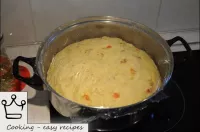 The dough is knocked out well and left to rise for one and a half to two hours. You need to knock out the dough to remove excess carbon dioxide. To do this, lift it several times and throw it on a clean cutting board. For further proofing for the specified time, the dough is again placed in a warm place, covered with a film so that a crust does not form on the surface.
The dough is knocked out well and left to rise for one and a half to two hours. You need to knock out the dough to remove excess carbon dioxide. To do this, lift it several times and throw it on a clean cutting board. For further proofing for the specified time, the dough is again placed in a warm place, covered with a film so that a crust does not form on the surface.  If you bake 1 large cake, any high saucepan with iron rather than plastic handles is suitable as a large shape. You can oil only the walls of the mold, and put a circle of parchment paper on the bottom of the mold so that it is easier to take out the finished cake. However, it is better to bake cakes from such a side dough in small forms. The dough is placed in a high form lubricated with vegetable oil and sprinkled with crushed crumbs.
If you bake 1 large cake, any high saucepan with iron rather than plastic handles is suitable as a large shape. You can oil only the walls of the mold, and put a circle of parchment paper on the bottom of the mold so that it is easier to take out the finished cake. However, it is better to bake cakes from such a side dough in small forms. The dough is placed in a high form lubricated with vegetable oil and sprinkled with crushed crumbs.  They wait for the dough in the molds to rise enough and put the cakes in the oven with low heat. The temperature of 160-170 degrees should be the first 15 minutes. At this time, the oven cannot be opened to avoid falling of the rising dough. Then the heating of the oven is increased to 190 degrees. The tops of the cakes are covered with either foil or baking paper. The total baking time depends on the size of the cake. If they take 1 large form, then such a cake, not yet baked, by weight will be about 1. 5 kg - it is baked 1 an hour. If the cooked dough is divided into 2 cakes, they are baked for 45 minutes. If small mold sizes are used, then bake for 30 minutes. Readiness is checked with a toothpick or any other wooden ray - it must come out of the cake dry.
They wait for the dough in the molds to rise enough and put the cakes in the oven with low heat. The temperature of 160-170 degrees should be the first 15 minutes. At this time, the oven cannot be opened to avoid falling of the rising dough. Then the heating of the oven is increased to 190 degrees. The tops of the cakes are covered with either foil or baking paper. The total baking time depends on the size of the cake. If they take 1 large form, then such a cake, not yet baked, by weight will be about 1. 5 kg - it is baked 1 an hour. If the cooked dough is divided into 2 cakes, they are baked for 45 minutes. If small mold sizes are used, then bake for 30 minutes. Readiness is checked with a toothpick or any other wooden ray - it must come out of the cake dry. 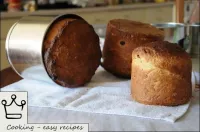 The finished cake is removed from the oven, placed on its side and left in this position until the bottom cools (3-4 minutes). Then the tsar's cakes are taken out of the mold and left "upside down" for further cooling. The main thing is not to leave the cake to cool in shape. In this case, the evaporating moisture can ruin the appearance of the finished cake.
The finished cake is removed from the oven, placed on its side and left in this position until the bottom cools (3-4 minutes). Then the tsar's cakes are taken out of the mold and left "upside down" for further cooling. The main thing is not to leave the cake to cool in shape. In this case, the evaporating moisture can ruin the appearance of the finished cake. It should be borne in mind that the dough for the royal cake will require a lot of your time to prepare the ingredients and for manual kneading. The tenderness and porosity of the finished pastry will depend on these components. The norm of products in the recipe is designed for 3 medium cakes (approximately 700 g each). Cake dough is not very sweet. For sweet tooth, the sugar rate can be increased to 300 g. Peeling almonds: boil a glass of water in a small saucepan, after boiling the water, pour almonds into it and boil for so 1 a minute. Water is drained. The peel of nuts should swell. Heat the oven to 100 degrees. While the oven is heating, a sharp tip is torn off each nut, pressed on the nut from the blunt edge so that it flies out of the peel. The peeled almonds are laid out on a baking sheet and put in a preheated oven for 20-25 minutes. The almonds are removed from the oven and allowed to cool slightly, then chopped.
 Español
Español Français
Français Português
Português Русский
Русский 简体中文
简体中文 繁體中文
繁體中文 日本語
日本語 한국어
한국어 العربية
العربية Türkçe
Türkçe Қазақ
Қазақ Deutsch
Deutsch Italiano
Italiano Українська
Українська
 Warm 250 g of cream in a saute pan. Dishes should be placed on the smallest fire so that the cream only warms up a little. A temperature of 35 degrees is quite enough (slightly warmer than the temperature of the hand), higher temperatures can suppress the activity of yeast in the future.
Warm 250 g of cream in a saute pan. Dishes should be placed on the smallest fire so that the cream only warms up a little. A temperature of 35 degrees is quite enough (slightly warmer than the temperature of the hand), higher temperatures can suppress the activity of yeast in the future.  While the cream is warming, measure 400 g of flour. If there are no kitchen scales, take 2. 5 cups of flour. The beaker should be 250 ml in volume.
While the cream is warming, measure 400 g of flour. If there are no kitchen scales, take 2. 5 cups of flour. The beaker should be 250 ml in volume.  Then the yeast (50 g) is diluted in a glass of warmed cream.
Then the yeast (50 g) is diluted in a glass of warmed cream.  While the steam rises, the remaining ingredients are prepared. Eggs are washed under warm running water (so that nothing from the shell gets into the dough when the egg is broken and the yolk is separated).
While the steam rises, the remaining ingredients are prepared. Eggs are washed under warm running water (so that nothing from the shell gets into the dough when the egg is broken and the yolk is separated).  The butter is transferred to a saute pan and melted without bringing to a boil. They take it off the fire. Allow to cool for 2-3 minutes.
The butter is transferred to a saute pan and melted without bringing to a boil. They take it off the fire. Allow to cool for 2-3 minutes. 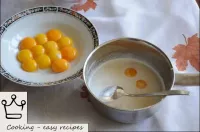 Yolks are added to the oil.
Yolks are added to the oil.  Then sugar is added and the mixture is triturated till slight increase in volume. You can rub with a fork or whisk, you can use a mixer, beating the mixture for 3 minutes.
Then sugar is added and the mixture is triturated till slight increase in volume. You can rub with a fork or whisk, you can use a mixer, beating the mixture for 3 minutes.  Spices and candied fruits are prepared. Boil a glass of water. Raisins are poured with them. Leave for 5 minutes.
Spices and candied fruits are prepared. Boil a glass of water. Raisins are poured with them. Leave for 5 minutes.  While the raisins are "steaming, " candied fruits are finely chopped.
While the raisins are "steaming, " candied fruits are finely chopped.  They throw raisins in a colander, let it dry on a towel.
They throw raisins in a colander, let it dry on a towel. 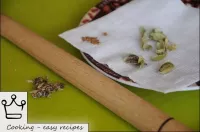 They take 10 boxes of cardamom and open them, removing the grains. Grains are laid on board and rolled out with rolling pin. If there is a mortar, you can thin the grain in it.
They take 10 boxes of cardamom and open them, removing the grains. Grains are laid on board and rolled out with rolling pin. If there is a mortar, you can thin the grain in it. 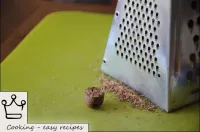 1 tinder nutmeg on a fine grater, pushed for more grinding. If the nut is not present as a whole, 1 tsp ground nutmeg can be used.
1 tinder nutmeg on a fine grater, pushed for more grinding. If the nut is not present as a whole, 1 tsp ground nutmeg can be used.  Measure 50 g of shredded almonds. Or take 40-45 nuts of dried almonds and peel it off (getting it into the dough can ruin the baking colour).
Measure 50 g of shredded almonds. Or take 40-45 nuts of dried almonds and peel it off (getting it into the dough can ruin the baking colour). 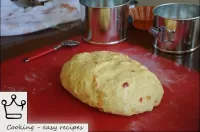 Then the dough is kneaded again (about 5 minutes).
Then the dough is kneaded again (about 5 minutes). 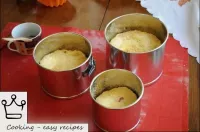 The mold (of any size) is filled to only half, the dough is allowed to rise again to the 3/4 height of the mold (the dough will rise within about 15-20 minutes). The less dough in the form, the more magnificent the baked cake will be.
The mold (of any size) is filled to only half, the dough is allowed to rise again to the 3/4 height of the mold (the dough will rise within about 15-20 minutes). The less dough in the form, the more magnificent the baked cake will be.  At this time, the oven is heated to 160 degrees. When it has already warmed up, to avoid dry baking, a container of hot boiled water is placed on the bottom of the oven.
At this time, the oven is heated to 160 degrees. When it has already warmed up, to avoid dry baking, a container of hot boiled water is placed on the bottom of the oven.  Thanks to the tax, the royal Easter cakes do not stale for a long time. Once completely cooled, they can be wrapped in a towel and left in a loaf or saucepan.
Thanks to the tax, the royal Easter cakes do not stale for a long time. Once completely cooled, they can be wrapped in a towel and left in a loaf or saucepan. 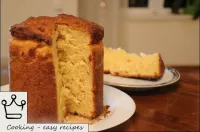 Tsar's cake is ready. Enjoy your meal!
Tsar's cake is ready. Enjoy your meal!